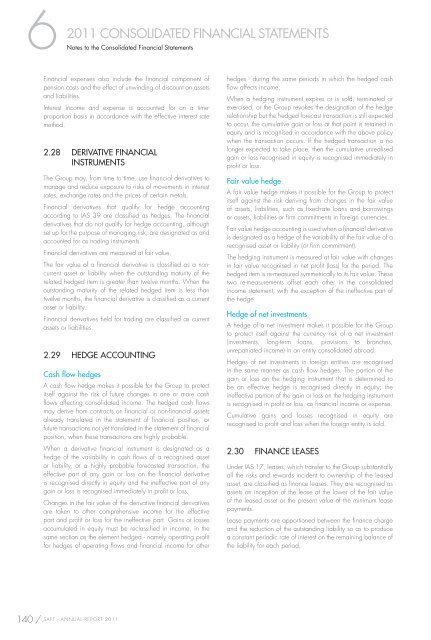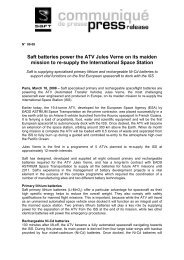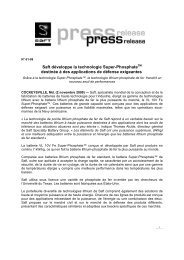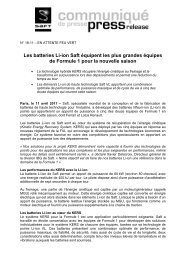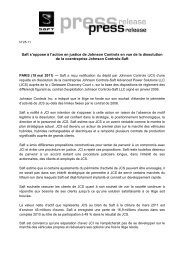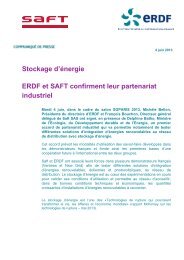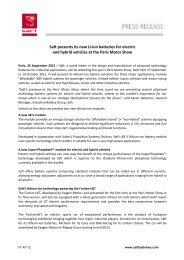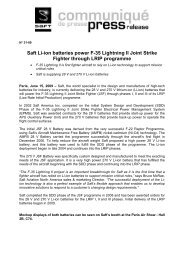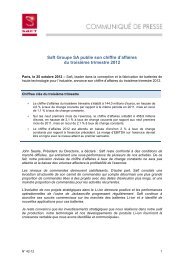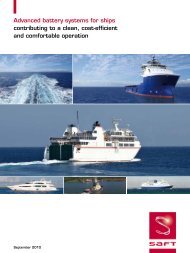ANNUAL REPORT 2011 REGISTRATION DOCUMENT - Saft
ANNUAL REPORT 2011 REGISTRATION DOCUMENT - Saft
ANNUAL REPORT 2011 REGISTRATION DOCUMENT - Saft
Create successful ePaper yourself
Turn your PDF publications into a flip-book with our unique Google optimized e-Paper software.
6 Notes<br />
<strong>2011</strong> CONSOLIDATED FINANCIAL STATEMENTS<br />
to the Consolidated Financial Statements<br />
Financial expenses also include the fi nancial component of<br />
pension costs and the effect of unwinding of discount on assets<br />
and liabilities.<br />
Interest income and expense is accounted for on a timeproportion<br />
basis in accordance with the effective interest rate<br />
method.<br />
2.28 DERIVATIVE FINANCIAL<br />
INSTRUMENTS<br />
The Group may, from time to time, use fi nancial derivatives to<br />
manage and reduce exposure to risks of movements in interest<br />
rates, exchange rates and the prices of certain metals.<br />
Financial derivatives that qualify for hedge accounting<br />
according to IAS 39 are classifi ed as hedges. The fi nancial<br />
derivatives that do not qualify for hedge accounting, although<br />
set up for the purpose of managing risk, are designated as and<br />
accounted for as trading instruments.<br />
Financial derivatives are measured at fair value.<br />
The fair value of a fi nancial derivative is classifi ed as a noncurrent<br />
asset or liability when the outstanding maturity of the<br />
related hedged item is greater than twelve months. When the<br />
outstanding maturity of the related hedged item is less than<br />
twelve months, the fi nancial derivative is classifi ed as a current<br />
asset or liability.<br />
Financial derivatives held for trading are classifi ed as current<br />
assets or liabilities.<br />
2.29 HEDGE ACCOUNTING<br />
Cash flow hedges<br />
A cash fl ow hedge makes it possible for the Group to protect<br />
itself against the risk of future changes in one or more cash<br />
fl ows affecting consolidated income. The hedged cash fl ows<br />
may derive from contracts on fi nancial or non-fi nancial assets<br />
already translated in the statement of fi nancial position, or<br />
future transactions not yet translated in the statement of fi nancial<br />
position, when these transactions are highly probable.<br />
When a derivative fi nancial instrument is designated as a<br />
hedge of the variability in cash fl ows of a recognised asset<br />
or liability, or a highly probable forecasted transaction, the<br />
effective part of any gain or loss on the fi nancial derivative<br />
is recognised directly in equity and the ineffective part of any<br />
gain or loss is recognised immediately in profi t or loss.<br />
Changes in the fair value of the derivative fi nancial derivatives<br />
are taken to other comprehensive income for the effective<br />
part and profi t or loss for the ineffective part. Gains or losses<br />
accumulated in equity must be reclassifi ed in income, in the<br />
same section as the element hedged - namely operating profi t<br />
for hedges of operating fl ows and fi nancial income for other<br />
140 / SAFT - <strong>ANNUAL</strong> <strong>REPORT</strong> <strong>2011</strong><br />
hedges - during the same periods in which the hedged cash<br />
fl ow affects income.<br />
When a hedging instrument expires or is sold, terminated or<br />
exercised, or the Group revokes the designation of the hedge<br />
relationship but the hedged forecast transaction is still expected<br />
to occur, the cumulative gain or loss at that point is retained in<br />
equity and is recognised in accordance with the above policy<br />
when the transaction occurs. If the hedged transaction is no<br />
longer expected to take place, then the cumulative unrealised<br />
gain or loss recognised in equity is recognised immediately in<br />
profi t or loss.<br />
Fair value hedge<br />
A fair value hedge makes it possible for the Group to protect<br />
itself against the risk deriving from changes in the fair value<br />
of assets, liabilities, such as fi xed-rate loans and borrowings<br />
or assets, liabilities or fi rm commitments in foreign currencies.<br />
Fair value hedge accounting is used when a fi nancial derivative<br />
is designated as a hedge of the variability of the fair value of a<br />
recognised asset or liability (or fi rm commitment).<br />
The hedging instrument is measured at fair value with changes<br />
in fair value recognised in net profi t (loss) for the period. The<br />
hedged item is re-measured symmetrically to its fair value. These<br />
two re-measurements offset each other in the consolidated<br />
income statement, with the exception of the ineffective part of<br />
the hedge.<br />
Hedge of net investments<br />
A hedge of a net investment makes it possible for the Group<br />
to protect itself against the currency risk of a net investment<br />
(investments, long-term loans, provisions to branches,<br />
unrepatriated income) in an entity consolidated abroad.<br />
Hedges of net investments in foreign entities are recognised<br />
in the same manner as cash fl ow hedges. The portion of the<br />
gain or loss on the hedging instrument that is determined to<br />
be an effective hedge is recognised directly in equity; the<br />
ineffective portion of the gain or loss on the hedging instrument<br />
is recognised in profi t or loss, as fi nancial income or expense.<br />
Cumulative gains and losses recognised in equity are<br />
recognised to profi t and loss when the foreign entity is sold.<br />
2.30 FINANCE LEASES<br />
Under IAS 17, leases, which transfer to the Group substantially<br />
all the risks and rewards incident to ownership of the leased<br />
asset, are classifi ed as fi nance leases. They are recognised as<br />
assets on inception of the lease at the lower of the fair value<br />
of the leased asset or the present value of the minimum lease<br />
payments.<br />
Lease payments are apportioned between the fi nance charge<br />
and the reduction of the outstanding liability so as to produce<br />
a constant periodic rate of interest on the remaining balance of<br />
the liability for each period.


